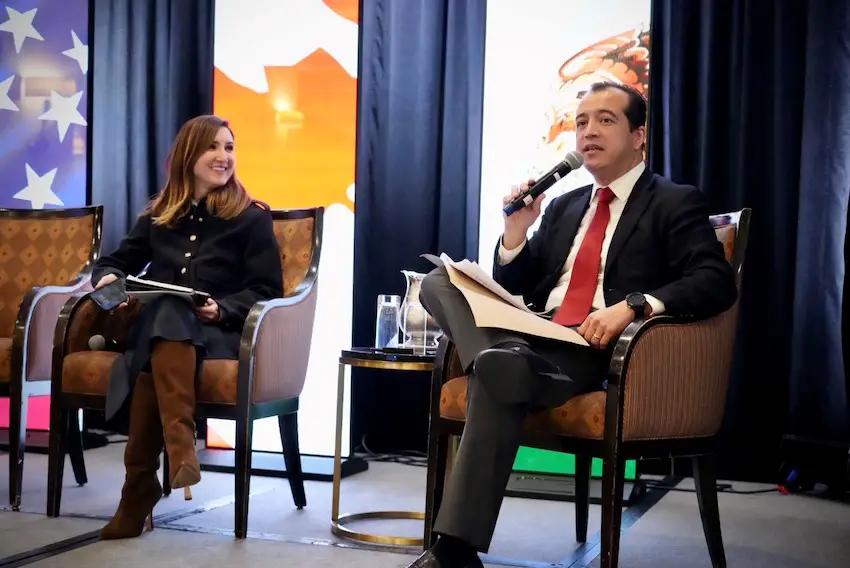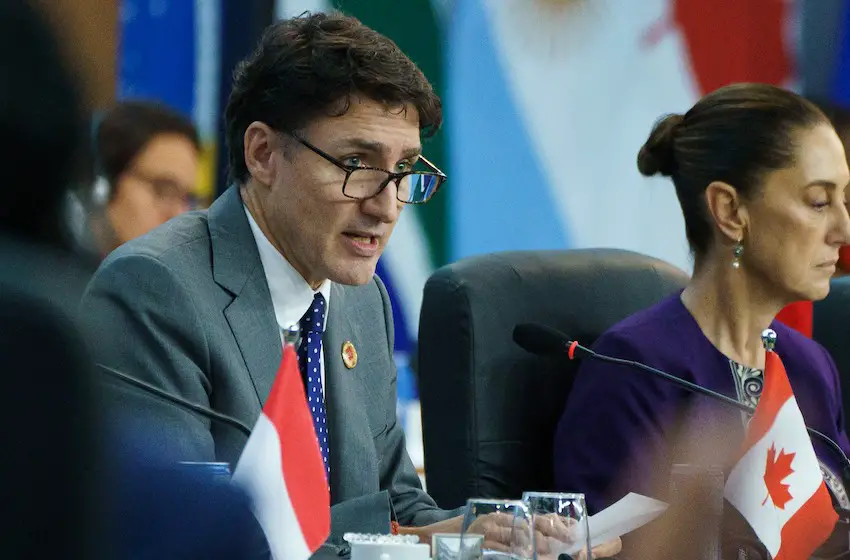Do Mexico, the United States and Canada need a common plan to increase manufacturing capacity in North America and reduce reliance on Chinese imports?
Economy Minister Marcelo Ebrard appears to believe they do, and floated the idea that Mexico should take the initiative and propose one to its northern neighbors and USMCA trade partners.

Speaking at a BBVA bank meeting in Cancún on Friday, Ebrard noted there is concern that North America is “losing competitiveness” relative to China.
Instead of responding to the situation as a North American bloc, “each country does what it thinks it should do,” the minister said.
In the U.S., for example, the Inflation Reduction Act was implemented to provide “huge incentives” to attract investment in the electric vehicle sector, Ebrard said, adding that China has an “advantage” over North America in that area.
He said that Mexico, the United States and Canada have had “certain common visions or at least certain common appreciations” about what needs to be done to increase North American production and reduce reliance on imports from China and some other Asian countries, “but we haven’t had a plan B” — i.e. a common backup plan that could support the initiatives of individual countries.
“Maybe Mexico can put that on the table — not be on the defensive but propose it,” Ebrard said.
What might a common plan entail?
Uniform tariffs?
While Ebrard didn’t go into details about what a common North American plan to increase production and reduce reliance on Chinese imports would look like, a likely starting point would be for Mexico, the United States and Canada to have uniform tariffs on Chinese imports.
The U.S. and Canada, for example, both impose 100% tariffs on Chinese electric vehicles, whereas Mexico’s tariffs on those vehicles are just 20%. Tariffs on various other Chinese products differ in the three North American countries.
Earlier this month, Ontario Premier Doug Ford accused Mexico of becoming a low-tariff “backdoor” into North America for Chinese products and asserted that “if Mexico won’t fight transshipment by, at the very least, matching Canadian and American tariffs on Chinese imports,” it should not be part of the North American free trade bloc.
Last Friday, President Claudia Sheinbaum rejected claims that Mexico has become a transshipment hub for Chinese goods.
In an interview with Mexico News Daily in June, former Mexican ambassador to China Jorge Guajardo said that imposing higher tariffs on Chinese imports to protect Mexican industry was a pressing and important task for the Sheinbaum administration.
Additional partnerships?
Mexico and the U.S. are already partnering in a semiconductor initiative whose ultimate aim is to strengthen and grow the Mexican semiconductor sector.
While Mexico, the U.S. and Canada already have integrated supply chains in various sectors, additional partnerships aimed at increasing manufacturing capacity in North America could also be part of a common plan, as proposed by Ebrard.

What is Mexico doing to increase local production and reduce its reliance on China?
Mexico’s Deputy Economy Minister for Foreign Trade Luis Rosendo Gutiérrez Romano told The Wall Street Journal last month that the federal government wants U.S. automakers and semiconductor manufacturers, as well as large aerospace and electronics companies, to substitute some goods and components made in China, Malaysia, Vietnam and Taiwan.
“We want to focus on supporting our domestic supply chains,” he said.
Ebrard said in October that the government was looking at “how we can reduce all the imports we have — that is, to increase domestic content in any way we can.”
In Cancún on Friday, the economy minister said that the government is working with “a lot of companies … to reduce the volumes of our imports from Asia, not just from China.”
“We have to increase our national content, but we have to work with the companies [in Mexico] that export,” said Ebrard, who pointed out last month that Mexican content in the country’s manufacturing exports is currently less than 20%.
Among the companies the government is working with to identify which Asian imports can be replaced with Mexican-made components are Foxconn, Intel, General Motors, DHL and Stellantis.
It remains unclear how quickly Mexico can reduce its reliance on Chinese imports, which have increased significantly in recent years.
But President Sheinbaum said Friday that the objective throughout her six-year term is to continually reduce reliance on Chinese exports.
“We have a plan that the Finance Ministry is developing with the Economy Ministry,” Sheinbaum said.
“[In 2018] President #Trump signed into law a round of tariffs on many Chinese imports… Tariffs haven’t slowed America’s demand for foreign goods. Many items are just finding new ways into the U.S.” – looks like trade diversion from China involves both Mexico & Canada.🤷🏽♂️ #USMCA https://t.co/CJyvKURXIL pic.twitter.com/BotfqgPmzf
— Mark Warner (@MAAWLAW) November 25, 2024
The objective of the plan, she said, is to “substitute imports that come from China” with goods made in Mexico either by Mexican companies or “companies mainly from North America.”
Finance Minister Rogelio Ramírez de la O has repeatedly highlighted that Mexico has a large and growing trade deficit with China.
However, he has also pointed out — and Sheinbaum emphasized this on Friday — that Mexico is not the only North American country that relies heavily on Chinese imports.
“The United States depends on China for 16.5% of its total imports, Canada depends [on China] for 13.5% and Mexico depends on China for 19.6% of its total imports,” Ramírez said in July.
The future of the USMCA
Mexico’s trade relationship with China, and Chinese investment in Mexico, are currently hot topics ahead of the inauguration of Donald Trump as U.S. president in January and the scheduled review of the USMCA in 2026.
Ebrard’s indication that Mexico is willing to work with the United States and Canada on a common plan to increase North America’s manufacturing capacity and reduce reliance on Asian imports appears to show that the Mexican government is determined to avoid or at least minimize China-related problems during the USMCA review process.

The economy minister previously said that Mexico — the world’s largest exporter to the United States — would “mobilize all legitimate interests in favor of North America” amid the ongoing China-U.S. trade war that could intensify after Trump takes office on January 20. For its part, the lower house of Mexico’s Congress modified a constitutional bill last week in an effort to ensure that a proposal that seeks to eliminate seven autonomous government agencies doesn’t violate the USMCA.
Trump said last month that he would “have a lot of fun” renegotiating the USMCA, while Canadian Prime Minister Justin Trudeau said last week that “pending decisions and choices that Mexico has made” Canada “may have to look at other options” vis-à-vis its trade relationships in North America.
Sheinbaum has repeatedly stressed that the free trade agreement benefits Mexico, the United States and Canada, and asserts that the three countries “complement” each other rather than “compete” with each other. More than 80% of Mexico’s total export revenue comes from products shipped to its immediate northern neighbor.
At this stage, it appears that Mexico’s trade and investment relationship with China will indeed be an issue at the 2026 review of the USMCA. However, it appears unlikely that it will prove to be a sticking point in negotiations aimed at extending the free trade pact, especially considering Mexico’s willingness — and efforts — to make modifications to its trade relationship with China.
Trudeau, who may not even be prime minister in 2026 given that Canada will hold a federal election in 2025, said last Thursday that Canada, Mexico and the United States would have to “lean in and work on” concerns related to Chinese investment in Mexico, but he stressed that his “first choice” was for the USMCA to continue.
Even if Canada, or the U.S., said in 2026 that they didn’t want to extend the USMCA, the three-way pact, under its terms, could not be terminated until 2036, and only after the three countries had met annually during an entire decade to try to find a solution to their differences.
On Friday, Ebrard expressed confidence that the USMCA review process will be successful, albeit “not easy.”
“… Don’t worry so much. … All we have to do is present sensible, convincing and personal arguments,” he said.
With reports from El Economista and La Jornada
